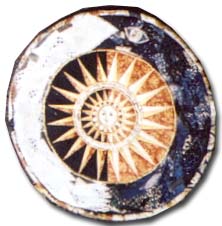a simple twist of seed
I was going about my work in the field site, when I decided to take a break. I drank some water from a bottle and then accidentally spilled some on the ground. The ground was dry and I was idly watching the wetness spread when suddenly I noticed something moving. Since I m always curious about insects and the like, I stooped down to see what it was. To my surprise, it wasn't an animal at all. It was a grass seed. The tip of the seed was embedded in the ground, and the rest of the seed was turning slowly and rather jerkily. I was able to recognize it instantly because the field site is overrun with this particular grass species, and the seed is adapted to be dispersed by animals. By this I mean that the seed is tipped with a pretty sharp thorn that instantly clings to anything that brushes past it. Namely me. Everyday I used to remove numerous such seeds from my clothes, shoes etc. So when I saw it moving in response to water, I was intrigued.
Later I went to a nearby coffee shop and after sitting down with a cup of coffee, I pulled out several seeds from my shoes and examined them closely. The tip was really sharp, but the rest of the seed was elongated. It looked for all the world like a miniature javelin twisted in two places. I wondered if coffee would have any impact. I put one seed carefully in the saucer and poured some coffee into it. The seed instantly started turning slowly clockwise; it used the twisted part as an pivot to try to push itself upright and dig into the saucer, but finding no purchase it just spun aimlessly. After a while, when the seed was fully wet, it stopped turning. I pulled it out of the coffee and saw that the seed had become completely straight. As the seed dried, it started turning again, till it finally reached its previous state.
It was very cool: an excellent adaptation for dry conditions. All the grass would need is a little bit of rain and it would be ready to dig into the soil. I guessed that the fertile part of the seed would be in the tip and the rest of the javelin structure was just a way to ensure that the seed enters the ground for further growth.
I was satisfied, it was an interesting adaptation, and I thought that it must be pretty well known. I spoke about this to a few people, including my friend J, who is a molecular parasitologist. Everyone was suitably impressed. J in particular was extremely interested in the mechanism behind the rotation. I was not too bothered; I had (more or less) figured out the ecological part of it, and that was good enough for me. J then did some searches on the net, but her google-fu wasn't bringing out any fresh information. She kept trying to get me more interested, and I reluctantly talked to a couple of botany lecturers and surprisingly they had no idea about this as well. Then we began to get really interested. J took some seeds to her lab and did a few tests on them. She took high magnification photographs that showed that the seed was a hollow cylinder, and the cylinder was densely packed with twisted microfibres. She even looked at the motion of the seed under the microscope and noted that the individual fibres reacted in the same way as the whole structure when the seed was dampened. She really wanted to find the exact reason, a molecular reason for the rotation, but couldn't due to lack of access to some chemicals and reagents that she needed. Then somebody told her the name of the plant: Heteropogon contortus. With a name like that it was quite obvious that the turning feature of the seed was well known and our quasi-investigation lost a lot of steam, even though there didn't seem to be much information available.
UPDATE:- J says :Actually these seeds also respond to heat which allows them to dig into the soil during fires, which protects them allowing them to germinate soon afterwards. And the twisting mechanism is very similar that of curly hair of the kind that straightens up when wet.The fibers are like that of cotton, which are hollow on the inside too . BTW I prefer to be called a biochemist rather than molecul......whatever.




<< Home